2017 Food Plant Construction Survey: Safety, consumers drive expansion
Processors realize that existing facilities must be updated and expanded to meet food safety regulations and increasing and challenging customer demands
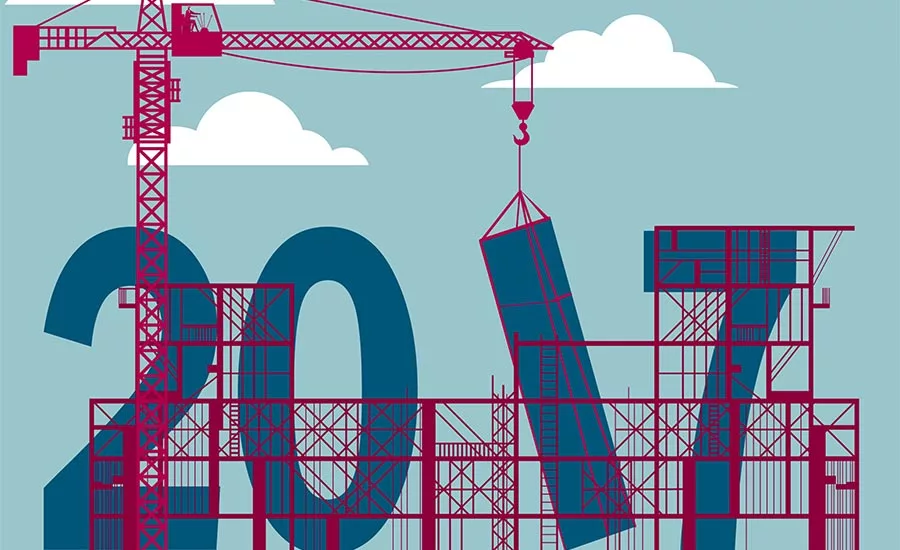
Click here to see the 2018 Plant Construction Survey!
This year’s FE Plant Construction Survey produced what seem to be surprising results, but on second thought, may reveal a trend perhaps not all that surprising.
For the last four surveys, the ratio of expansion and renovation projects to new projects has steadily been increasing, showing almost a 2.5 to one ratio for the year 2016—for which we’re reporting. (See graph, “Renovations and expansions compared to new projects.”)
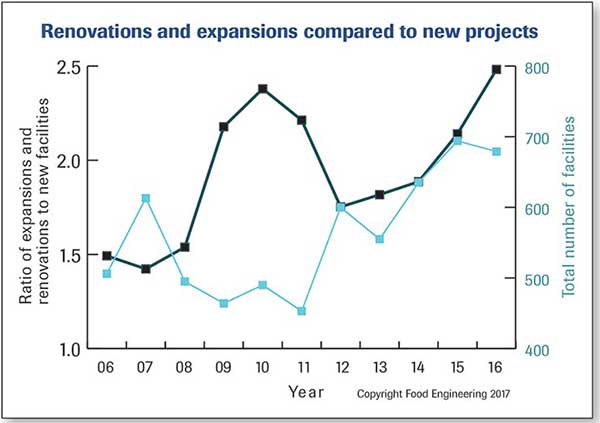
In the last 11 years, the ratio was at its lowest in 2007 (1.42), then increasing to a high of 2.2 in 2010, then decreasing again in 2012, only to rise to its highest in 2016. This begs the question: Why for every five of expansion/renovation projects would there be only two new projects? The diagram “2014, 2015 and 2016 Projects” shows that for the last three years, new projects were getting a smaller piece of the total projects pie than expansions and/or renovations.
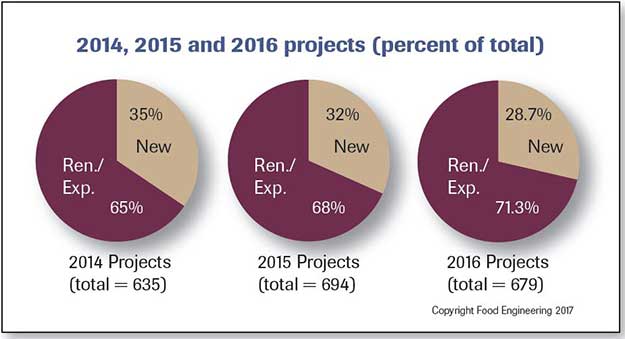
A key reason for the increased number of renovations and expansions compared to new projects might be that processors are trying to make their facilities compatible with FSMA (if they’re not under USDA regulations) before inspectors arrive on premises to find fault with indoor air quality, roof leaks, cleanliness, allergen contamination, and the list goes on.
As one A&E principal explained, processors know they have to comply with FSMA, so they’ll try to renovate and repair to bring their building up to snuff. Expansions make sense if they can add on without disrupting current processing/packaging operations. When all these possibilities are not amenable, then it’s time to find a new greenfield site or tear down the old facility and build a new facility on the property.
FSMA, however, is not always the key reason for expansions and renovations.
“There has been an increase over the past few months regarding expansions and renovations,” reports A M King’s Stuart Jernigan, preconstruction executive. “Most are geared towards increasing throughput either by increased efficiency, additional lines or both.”
What’s important this year?
A&E/C (architectural and engineering/construction) firms were asked about the biggest trends they saw in 2016, which are listed in the box, “Top 10 trends.”
Compared to last year’s survey (2016), processors are faced with two big issues that can force their hands with facilities: prepare their facility for FSMA or GFSI accreditation—and at the same time, increase production to meet customer demand.
A&E/C firms and their clients both agree that flexibility is the key word for any design—make the design flexible, so processors can have flexible equipment and lines to meet new and changing products, especially important to Millennials as they look for clean label products.
Demand has changed the rules for some processors.
“We’re seeing an impressive uptick in expanded production for specialty and premium products,” says Mark Di Gino, E.A. Bonelli + Associates marketing manager. “This clearly seems driven by consumer trends; people are buying more artisanal, organic and specialty food products, and because they’re willing to spend more money on them, larger stores are starting to carry these items. Many of our clients over the last year approached us because of the same reason: Consumer demand swelled so much, they couldn’t afford to grow steadily and needed to consider new construction to meet the immediate demands of wholesalers.”
Why new? Harlan VandeZandschulp, Gleeson Constructors & Engineers president, explains that some of his clients prefer new over renovating because they want to build what they want and not impact current production. Also, he says more companies are paying more attention to sustainable production practices, such as increasing water and energy savings. Overcoming these types of issues can be difficult.
To meet the second trend of increasing production, A&E/C firms report that clients expect fast project deployment, but more than that, it has to be right at startup.
“Technology is playing the biggest role in how we deliver solutions—and it’s changing rapidly,” says Stellar’s Todd Allsup, vice president of sales. “3D design lets you tour a plant before it’s built, drones are used to verify accuracy on project sites, and cutting-edge lasers can measure within millimeters of accuracy.”
With this 3D equipment and software come virtual reality (VR) and augmented reality (AR) viewing systems, so processors can “walk the plant” before it’s built. No surprise head-knockers, no collisions of piping—just an optimized plant where workers will be safe, and equipment will be staged to make it efficient and versatile.
“Thanks to recent technology breakthroughs, the use of VR is simultaneously expediting and improving the design-build world,” says Jeffrey Beran, Epstein project engineer. “Who doesn’t want to execute projects more quickly while delivering a better-quality product to their clients?”
With copious amounts of data being created, understanding how to properly use it can help complete projects on time, under budget and without surprises. Project planning has become more robust, adds Allsup, and budgets are more closely monitored. Manufacturers want assurance that what they ask for is actually what they need. Processors are more willing to invest in pre-engineering, so they have higher confidence in investment costs before starting a project.
While automation ranked the highest in importance in last year’s (2015) study, it only ranks sixth this year—perhaps because automation is just assumed. Environmental air handling ranks higher than automation this year, which could be explained by FSMA’s more stringent demands on air quality.
In terms of sustainability, A&E/C firms indicated that because energy has become less expensive—partly due to increasing volumes of natural gas—processors are not quite so worried about energy costs, unless they are in an area where electrical energy is expensive. More important, however, is the availability of potable water as a process input and, especially, how to deal with wastewater being sent to the POTW. A&E/C firms reported an increase in the construction and enhancement of on-site wastewater treatment systems—to the point where the construction of an on-site treatment plant is as vital as the process or packaging line.
What the numbers say
The total number of food and beverage projects in 2016, which is 679, represents a 2.2 percent decrease in the number of projects reported in 2015, the highest recorded in the last 11 years at 694. (See “Plant construction projects [2006-2016].”)
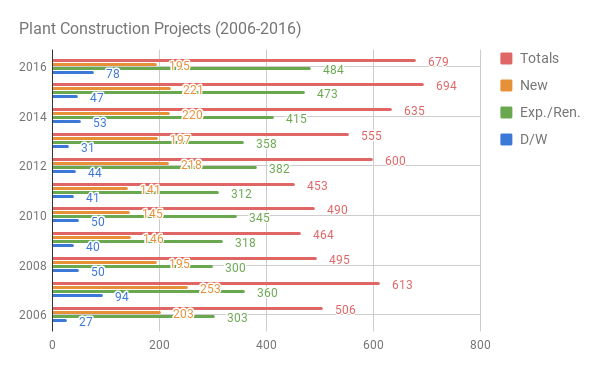
However, 2016’s total number of projects surpassed 2014 (635 projects) by 6.9 percent and was 20.8 percent higher than the 11-year simple average of 562 projects. The number of new projects in 2016 totaled 195, down 11.8 percent from the 2015 number of 221, but still half a percent higher than the 11-year simple average of 194. On the other hand, 2016’s number of expansion/renovation projects was 484 (actually 2.3 percent higher than 2015’s number of 473).
Reportable food and beverage projects are those valued at over $1 million. They have been made public by the processor, a government entity (including local or state economic development groups) or the A&E/C firms responsible for them.
The survey (though the table lists “Completion Date” at the header) includes projects begun, announced by any entity or completed in 2016. If dates listed are beyond 2016, they reflect the projected completion date for a project either announced in 2016 or currently underway. Keep in mind, some projects can be announced, then dropped at the last minute for any number of reasons, e.g., legal problems, lack of expected funding, site issues, changing needs, politics, etc.
This year’s report found distribution centers (DCs)/warehouse sites, whether new or renovations/expansions, increased significantly over the preceding year, in fact 66 percent higher. DCs/warehouses this year totaled 78 compared to 2015’s number of 47 sites. In fact, it was the second-highest number in the last 11 years, surpassed only by 2007’s number of 94 sites.
These DCs include separate, standalone warehouses either owned by a food and beverage processor or by a freezer/cold storage warehouse provider like US Cold Storage—or they can be on premises with processing and packaging equipment, often separated by a wall or located conveniently in another building where conveyance may be built to connect storage and processing/packaging. Finally, DCs in 2016 numbered 52 percent above the 11-year simple average of 51.4 percent.
We’ve been tallying alcoholic beverage projects (whether new or expansions/renovations and/or DCs) since 2012, as we began to get several announcements of new craft beer companies and craft distillers—though beer makes up the lion’s share of projects. (See “Alcoholic beverage projects 2012-2016.”) The number of alcoholic beverage projects totaled 70 in 2016, down by 22 percent (20 projects) recorded in 2015 (90). The tally in 2016 marks a 10.3 percent increase over the five-year simple average of 65 projects. Bottle or barrel-making projects are not included in the tally.
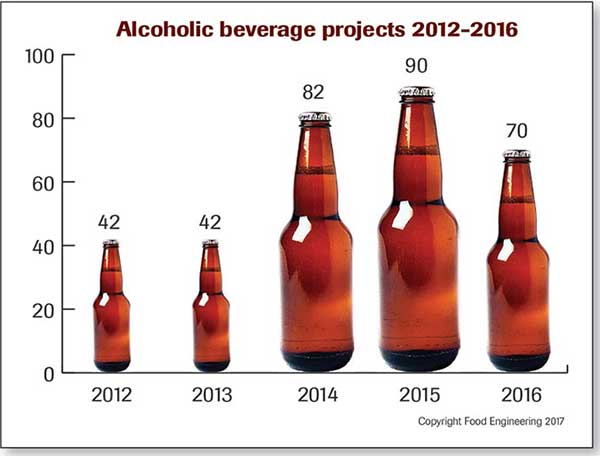
Hot buttons
What are the hot trends?
“Increased focus and spending on plant upgrades both to increase production, as well as comply with FSMA and SQF certification,” says Mark Galbraith, co-owner of Galbraith Pre-Design.
Processors are getting ready for FSMA, and they’re planning to get more out of their existing facilities. However, some might be concerned about acquiring too much automation too fast due to lack of skilled labor that can operate advanced equipment, reports Mark Redmond, president at Food Plant Engineering.
“Manufacturers want to produce more with the same number of people,” Redmond says. “I see a lot of what I call ‘spot automation’—automating certain parts of the process. This saves money and improves food safety.”
“We are seeing two key trends happening today,” says Chris Jarc, vice president and project manager at Hixson Architecture and Engineering. “First, FSMA has definitely impacted building and utility design. We’ve always designed our facilities in such a way that they meet 99 percent of FSMA requirements, e.g., making sure water drains [no puddles], designing HVAC with proper air change rates, proper lighting and other back-of-house functions to handle loads. However, one of the biggest changes is the fact that allergen separation has gone from ‘should’ to ‘shall.’ To help with this, plant design needs to provide more access controls, additional staging areas for verification and improved line separations, either by physical distance or other means.”
An excellent example of this can be seen in FE’s 2017 Food Plant of the Year, Abbott’s Tipp City, Ohio plant, for which Hixson provided architectural and engineering support for a new second line and associated modifications. After entering the facility, raw materials are segregated into refrigerated storage and ambient storage, and any ingredients containing potential allergens and non-GMO ingredients are segregated to prevent unwanted crossover. Blending of powders and liquids is also separated, rather than taking place all in one room as is done in many facilities, to further facilitate dust control and prevent allergen migration.
Another important trend Jarc sees is the use of building management systems (BMSs) that provide data off the floor for downtime reporting, mean time to failure analyses and other reports.
“Plus, BMSs are now capturing utility data from boilers, electrical systems and other ‘back-of-the-house’ systems to allow maintenance personnel to schedule maintenance programs and minimize costly downtime,” adds Jarc.
Top 10 Trends for 2016-2017*
- Preparing for FSMA regulations/GFSI certification
- Increasing production to meet demand (tied with 3)
- Flexibility in plant design and manufacturing
- Fast project deployment
- Environmental/air handling
- Automation
- Virtual reality/augmented reality/3-D design tools (tied with 8, 9 & 10)
- Sustainability (water and energy)
- Upgrades to existing plants/equipment
- Employee welfare, break rooms, etc.
*Based on the open-ended question in FE's 2016 Plant Construction Survey, "What trends do you see merging in plant construction projects? To what do you attribute these trends?"
Flexible design translates into flexible operation
Flexibility was the third-most often cited key trend affecting processors today. To allow processors to respond more quickly to changing consumer demand and have a greater speed to market, an increased focus is now placed on flexible manufacturing and designing plants to enable it.
“Design considerations focus on identifying key process modules that could be easily exchanged or modified, as well as to allow for future flexible space in production,” says Donald Oberlies, vice president/market leader at Alberici Contractors.
Flexibility can also be incorporated into the plant design elements through a greater emphasis on sanitary and cleaning needs.
“Processors are pressured to make many products in their plants, which must be economical and, thus, require quick turnovers and easy cleaning for a profitable operation,” says Pablo Coronel, CRB director of food processing and food safety. “Flexibility is built into the design by minimizing pipe runs and eliminating hard-to-clean areas. Also critical to success, systems should be easily modified to match the different processes.”
“Layout is the key,” says Jeff Stewart, Amec Foster Wheeler project director. “Making sure that you design a production line with a space that allows for flexible insertion or removal of equipment to meet differing demands makes all the difference. It’s never about electrical power, PLC controls or upstream processing. It is almost always about space.”
Additionally, reflecting on the entire lifespan of a plant can help inform flexible design, including possible future uses and expansions.
“Flexibility can be accommodated to an extent by thinking through all future alternatives and working into the initial layout, allowing space for anticipated equipment alternatives and linear flows, which allows for easier expansion,” says Ed Wright, senior director of project planning at The Austin Company.
For instance, size utility rooms and piping for some future expansion, but don’t install the additional compressor or boiler right away, recommends Keith Perkey, Haskell vice president, food and beverage.
“We might also design expansion panels into the facility to allow for cost-effective expansion in the future,” he says. “Another strategy is to allow for manufacturing suites that can be changed with minimal capital from one product to the next as consumer trends change.”
How does design translate into real-world flexibility?
“A flexible manufacturing operation generally falls into two main categories,” says Austin’s Ronaldo Gilberti, senior director of project planning.
The first, machine flexibility, refers to the changeability of the system to produce new products and the ability to change the order of operations in product lines. The second, routing flexibility, allows usage of multiple machines to perform the same operations on a product, as well as the system’s ability to absorb large-scale changes, such as in volume, capacity or capability.
Fast, innovative project deployment
Getting plants up and running is more important than ever today.
“Plants are being built quicker and quicker; speed to market in getting new products to the consumers [is key],” says Jeff Jendryk, Ambitech Engineering senior manager business development.
Modular construction is one way to speed the deployment process.
“One major trend I see is process modularization,” says Lloyd Snyder, Woodard & Curran senior vice president. “This is being widely used in construction due to many benefits to developing a process skid.”
The skid allows for assembly away from the construction site, which means lower cost, improved quality and safer process development. Skids also minimize startup schedules by allowing more testing and commissioning by having FATs already finished before arriving at the site, says Snyder.
Today, project development has to be more than just fast. It also has to be innovative.
“Plants are being built quicker and quicker; speed to market in getting new products to the consumers [is key].”
– Jeff Jendryk
“What we are seeing is two pronged,” says Sam Thurber, SSOE Group senior project manager. “The first is the need to show innovation—quickly and often. Projects which are innovative, or can be marketed as such, are getting green lighted.”
The second prong is that all projects are coming under greater scrutiny for regulatory, quality and safety compliance, adds Thurber. A project must be designed to create safe food and protect employees from hazards.
To ensure faster project delivery and deployment, certain steps must not be overlooked, according to Thurber. For example, delivery requirements include:
- Greater focus on not harming existing processing during construction
- Greater protection of employees and product during construction
- Greater regulatory compliance during the construction effort.
“We are seeing a few trends: more activity and faster timelines, which both drive the need for single-source accountability,” says Haskell’s Perkey. “The single-source accountability is often referred to as an EPC [Engineering, Procurement and Construction] project delivery model, where one entity takes full responsibility for the design, construction, installation, commissioning, startup and performance of food and beverage manufacturing facilities and equipment lines.”
This allows processors to shift the risk of project implementation from themselves to contract service providers.
Sustainability issues
Energy, water supply and wastewater treatment continue to be important factors in the decision process of any design project, says Thomas Wiersma, C2AE director of marketing and business development.
As with all considerations, each option must be estimated for initial cost versus long-term maintenance.
“Energy is always a topic of design, but is not driving new projects itself, as energy is currently cheap,” says Matt Williamson, ADF Engineering process department manager. “However, wastewater and water treatment are hot topics, and we are working on a number of wastewater projects. I would say that wastewater systems are the norm for larger facilities.”
Why the urgency for on-site wastewater treatment systems?
“Municipal wastewater treatment system infrastructures are typically of the same antiquated vintage as our bridges and tunnels,” says Mike Golden, Food Tech VP. “You don’t want to get that unexpected and large surcharge bill in the mail one day. [Therefore], proper analysis of wastewater chemistry and volume is a critical element of the design process.”
“More municipalities are requiring production facilities to install pretreatment wastewater plants to mitigate the impact on their public WWTP facilities,” says Jack Michler, ESI Group USA regional manager.
Industrial pretreatment requirements are constantly changing, depending on the policies and practices of the local municipality and utilities owners. The designer and project owner need to make reasonable predictions regarding the discharge limits to assess the surcharges on untreated outflow in comparison to the initial cost and on-going maintenance of a pretreatment system.
“Wastewater treatment systems are becoming the norm, to the level of reusing by-product streams for gray water applications,” says Steve Tippmann, executive vice president of the Tippmann Group. “When looking at water as an ingredient, any reduction of potable water usage is always the key.”
Curbing energy usage
Even though natural gas prices have come down, the cost of energy is still a design concern. “Energy can contribute significantly to the total operational cost of a wastewater treatment system,” says Dan McCreary, Dennis Group principal.
“Energy efficiencies in all utilities are reviewed concurrent with facility design, and in general, efficiencies gained within a specific customer-related ROI are typically implemented within the capital budget,” adds Tippmann.
Meeting FSMA regulations imposes in some cases new energy demands. This includes HVAC and refrigeration systems, which can be large energy users, says Food Tech’s Golden.
“This increased refrigeration demand and load forces operators to take a hard look at energy costs, which in turn forces an evaluation of the central refrigeration system and potential energy-efficiency upgrade opportunities.”
The shift in cost and availability of fuel sources away from oil and coal to natural gas and other renewable resources have had a significant effect on the design of facilities, says Haskell’s Perkey.
“Facilities are trending toward using more cost-effective fuel sources like natural gas to fuel packaged electrical generators and harvest the heat from those generators to produce hot water and steam for cleaning and other manufacturing processes.”
The human element not forgotten
Even though employee welfare registered 10th on our hot trends list, the subject hasn’t fallen on deaf ears.
“We have seen a move to health and wellness for plant employees and a move to more collaborative work environments that you may typically see in other work environments like commercial offices,” says Jonathan Marshall, Faithful+Gould senior vice president, manufacturing sector lead.
The creation of huddle spaces, “downtime” areas when on breaks, and generally more “daylighting” allow plant employees to be connected to what is going on outside the four walls of the plant.
“In numerous instances, we are now including workout gyms in plants and [the] creation of collaborative workplace solutions on the front of plant areas, as well as for self-directed teams to better plan and manage their work,” Marshall says.
Beyond the manufacturing walls, reductions regarding noise and light pollution have also become big drivers in certain geographic areas, adds Jernigan.
“Plant safety must focus on the safety of people and food,” says Greg Carr, The Austin Company senior director of project planning. “No longer are maintenance staff [members] ready to climb ladders to access equipment, for example, tops of tanks or rooftop equipment.”
Also, many plants are providing easier ways to view the process without actually entering the plant. This can have a few advantages, including using the plant floor as part of the sales process.
“Plant owners want to create an environment where they can show a prospective client the product—and the process to manufacture it—in a way that’s persuasive,” says Stellar’s Allsup. “For example, viewing corridors and observation decks act as a convenient and elegant display tool that doesn’t involve gearing up in gowns and hair nets.”
Additionally, the current trends of transparency and consumers demanding more information about the foods they eat might also be raising the importance of these viewing areas.
“In today’s world, consumers and partners place a higher value on visibility, assurance of product quality, food safety and the origin of products,” adds Allsup.
The following companies and individuals participated in the Food Engineering survey:
A M King
Stuart Jernigan
704-365-3160
ADF Engineering, Inc.
Matt Williamson
937-847-2700
Alberici Constructors
Donald C. Oberlies, PE
314-733-2341
Ambitech Engineering Corp.
Jeff Jendryk
630-270-7809
Amec Foster Wheeler
Dean Weber
612-252-3651
C2AE
Thomas Wiersma
616-454-9414
CMC Design-Build, Inc.
Nathan Larose
617-328-7899
CRB
Pablo Coronel, PhD
919-334-7067
Dennis Group
Dan McCreary
413-787-1785
E.A. Bonelli + Associates, Inc.
Mark Di Gino
510-740-0155
Epstein
Jeffrey W. Beran, PE
312-429-8049
ESI Group USA
Jack Michler
262-369-3526
Faithful+Gould
Jonathan Marshall
612-656-6104
Food Plant Engineering, LLC
Mark E. Redmond, PE
513-488-8888
Food Tech
Mike Golden
781-929-7369
Galbraith Pre-Design, Inc.
Mark Galbraith
717-226-5203
Gleeson Constructors & Engineers LLC
Harlan VandeZandschulp
712-258-9300
Gray Construction
Tyler Cundiff
859-281-9255
Haskell
Keith Perkey
678-328-2908
Hixson Architecture & Engineering
Chris Jarc, PE PMP, LEED AP
513-241-1230
SSOE Group
Sam Thurber
419-255-3830
Stellar
Todd Allsup
904-260-2900
The Austin Company
Susan Riffle
440-544-2268
Tippmann Group
Steve Tippmann
260-490-3000
Woodard & Curran
Lloyd Snyder, PE
207-415-7512
Looking for a reprint of this article?
From high-res PDFs to custom plaques, order your copy today!






